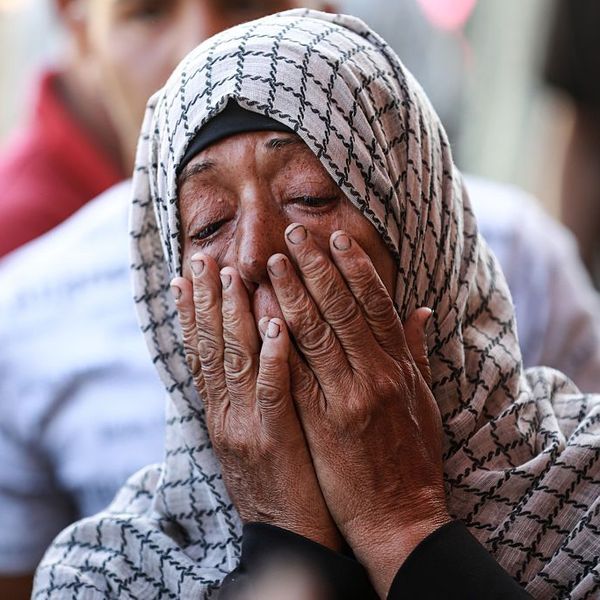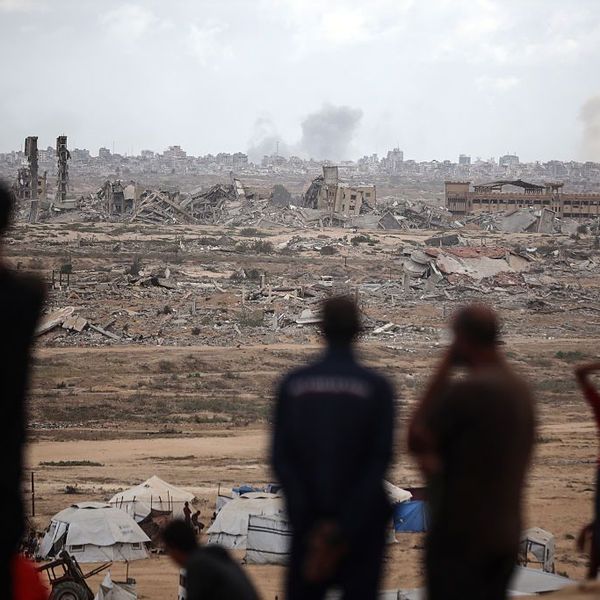Erik
Fosse, a Norwegian cardiologist, worked in Gaza hospitals during the
recent war."It was as if they had stepped on a mine," he says
of certain Palestinian patients he treated. "But there was no shrapnel
in the wound. Some had lost their legs. It looked as though they had
been sliced off. I have been to war zones for 30 years, but I have
never seen such injuries before."
Dr. Fosse was describing the effects of a U.S. "focused lethality"
weapon that minimizes explosive damage to structures while inflicting
catastrophic wounds on its victims. But where did the Israelis get this
weapon? And was their widespread use in the attack on Gaza a field test
for a new generation of explosives?
DIMEd to Death
The specific weapon is called a Dense Inert Metal Explosive (DIME). In 2000, the U.S. Air Force teamed up
with the University of California's Lawrence Livermore National
Laboratory. The weapon wraps high explosives with a tungsten alloy and
other metals like cobalt, nickel, or iron in a carbon fiber/epoxy
container. When the bomb explodes the container evaporates, and the
tungsten turns into micro-shrapnel that is extremely lethal within a
13-foot radius. Tungsten is inert, so it doesn't react chemically with
the explosive. While a non-inert metal like aluminum would increase the
blast, tungsten actually contains the explosion to a limited area.
Within the weapon's range, however, it's inordinately lethal. According to
Norwegian doctor Mad Gilbert, the blast results in multiple amputations
and "very severe fractures. The muscles are sort of split from the
bones, hanging loose, and you also have quite severe burns." Most of
those who survive the initial blast quickly succumb to septicemia and
organ collapse. "Initially, everything seems in order...but it turns out
on operation that dozens of miniature particles can be found in all
their organs," says Dr. Jam Brommundt, a German doctor working in Kham
Younis, a city in southern Gaza. "It seems to be some sort of explosive
or shell that disperses tiny particles...that penetrate all organs, these
miniature injuries, you are not able to attack them surgically." According to Brommundt, the particles cause multiple organ failures.
If by some miracle victims resist those conditions, they are almost
certain to develop rhabdomyosarcoma (RMS), a particularly deadly cancer
that deeply embeds itself into tissue and is almost impossible to
treat. A 2005 U.S. Department of health study found that tungsten stimulated RMS cancers even in very low doses. All of the 92 rats tested developed the cancer.
While DIMEs were originally designed to avoid "collateral" damage
generated by standard high-explosive bombs, the weapon's lethality and
profound long-term toxicity hardly seem like an improvement.
It appears DIME weapons may have been used in the 2006 Israeli
invasion of Lebanon, but not enough to alarm medical workers. But in
Gaza, the ordinance was widely used. Al-Shifta alone has seen 100 to 150 victims of these attacks.
Gaza as Test
Dr. Gilbert told the Oslo Gardermoen, "there is a strong suspicion...that Gaza is now being used as a test laboratory for new weapons."
DIME is a U.S. invention. Did the Israelis get the weapons from the
United States, or did they design similar ones themselves? Given the
close relations between the two militaries, it isn't unlikely that the
U.S. Air Force supplied the weapons or, at least, the specifications on
how to construct them. And since the United States has yet to use the
device in a war, it would certainly benefit from seeing how these new
"focused lethality" weapons worked under battlefield conditions.
Marc Garlasco, Human Rights Watch's senior military advisor, says
"it remains to be seen how Israel has acquired the technology, whether
they purchased weapons from the United States under some agreement, or
if they in fact licensed or developed their own type of munitions."
DIME weapons aren't banned under the Geneva Conventions because they
have never been officially tested. However, any weapon capable of
inflicting such horrendous damage is normally barred from use,
particularly in one of the most densely populated regions in the world.
For one thing, no one knows how long the tungsten remains in the
environment or how it could affect people who return to homes attacked
by a DIME. University of Arizona cancer researcher Dr. Mark Witten, who
investigates links between tungsten and leukemia, says
that in his opinion "there needs to be much more research on the health
effects of tungsten before the military increases its usage."
Beyond DIMEs
DIMEs weren't the only controversial weapons used in Gaza. The
Israeli Defense Forces (IDF) also made generous use of white
phosphorus, a chemical that burns with intense heat and inflicts
terrible burns on victims. In its vapor form it also damages breathing
passages. International law prohibits the weapon's use near population
areas and requires that "all reasonable precautions" be taken to avoid
civilians.
Israel initially denied using the chemical. "The IDF acts only in
accordance with what is permitted by international law and does not use
white phosphorus," said Israel's Chief of Staff Gabi Ashkenazi on January 13.
But eyewitness accounts in Gaza and Israel soon forced the IDF to
admit that they were, indeed, using the substance. On January 20, the
IDF confessed
to using phosphorus artillery shells as smokescreens, as well as 200
U.S.-made M825A1 phosphorus mortar shells on "Hamas fighters and rocket
launching crews in northern Gaza."
Three of those shells hit the UN Works and Relief Agency compound on
January 15, igniting a fire that destroyed hundreds of tons of
humanitarian supplies. A phosphorus shell also hit Al-Quds hospital in
Gaza City. The Israelis say there were Hamas fighters near the two
targets, a charge that witnesses adamantly deny.
Donatella Rovera of Amnesty International said:
"Such extensive use of this weapon in Gaza's densely-populated
residential neighborhoods...and its toll on civilians is a war crime."
Israel is also accused of using depleted uranium ammunition (DUA),
which a UN sub-commission in 2002 found in violation of the Universal
Declaration of Human Rights, the UN Charter, the Geneva Conventions,
the International Convention Against Torture, the Conventional Weapons
Convention, and the Hague Conventions against the use of poison weapons.
DUA isn't highly radioactive, but after exploding, some of it turns
into a gas that can easily be inhaled. The dense shrapnel that survives
also tends to bury itself deeply, leaching low-level radioactivity into
water-tables.
War Crimes?
Other human-rights groups, including B'Tselem, Gisha, and Physicians
for Human Rights, charge that the IDF intentionally targeted medical
personal, killing over a dozen, including paramedics and ambulance
drivers.
The International Federation for Human Rights called on the UN Security Council to refer Israel to the International Criminal Court for possible war crimes.
Although the Israelis dismiss the war-crimes charges, the fact that
the Israeli cabinet held a special meeting on January 25 to discuss the
issue suggests they're concerned about being charged with
"disproportionate" use of force. The Geneva Conventions
require belligerents to at "all times" distinguish between combatants
and civilians and to avoid "disproportionate force" in seeking military
gains.
Hamas' use of unguided missiles fired at Israel would also be a war crime under the Conventions.
"The one-sidedness of casualty figures is one measure of disproportion," says
Richard Falk, the UN's human rights envoy for the occupied territories.
A total of 14 Israelis have been killed in the fighting, three of them
civilians killed by rockets, 11 of them soldiers, four of the latter by
"friendly fire." Some 50 IDF soldiers were also wounded.
In contrast, 1,330 Palestinians have died and 5,450 were injured, the overwhelming bulk of them civilians.
"This kind of fighting constitutes a blatant violation of the laws
of warfare, which we ask to be investigated by the Commission of War
Crimes," a coalition of Israeli human rights groups and Amnesty
International said in a joint statement. "The responsibility of the state of Israel is beyond doubt."
Enter the Hague?
Israeli Prime Minister Ehud Olmert said that Justice Minister Daniel
Friedmann would coordinate the defense of any soldier or commander
charged with a war crime. In any case, the United States would veto any
effort by the UN Security Council to refer Israelis to the
International Court at The Hague.
But, as the Financial Times points out,
"all countries have an obligation to search out those accused of
'grave' breaches of the rules of war and to put them on trial or
extradite them to a country that will."
That was the basis under which the British police arrested Chilean dictator Augusto Pinochet in 1998.
"We're in a seismic shift in international law," Amnesty International legal advisor Christopher Hall told the Financial Times, who says Israel's foreign ministry is already examining the risk to Israelis who travel abroad.
"It's like walking across the street against a red light," he says.
"The risk may be low, but you're going to think twice before committing
a crime or traveling if you have committed one."

